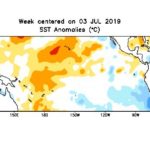Reuters — The El Nino weather pattern is likely to transition into ENSO-neutral conditions in the next month or two, a U.S. government weather forecaster said on Thursday. “ENSO-neutral” refers to periods in which neither El Nino nor La Nina is present, according to the National Weather Service’s Climate Prediction Center (CPC). ENSO-neutral conditions are […] Read more

El Nino seen transitioning to neutral in next month or two

El Nino pattern could emerge by 2018-19 winter
Reuters — The El Nino weather pattern, associated with warmer and wetter weather than usual that may give rise to damaging conditions, could emerge by the 2018-19 Northern Hemisphere winter, with neutral conditions expected to prevail through November this year, a U.S. government weather forecaster said on Thursday. The last El Nino, a warming of […] Read more

May showers likely to leave growers unsatisfied
CNS Canada — Canada’s Prairies can expect to see regular rainfall in most regions during May, but it likely won’t be enough to offset dry conditions recorded over the past several months. According to Drew Lerner of World Weather Inc. in Kansas City, the first half of May should see average rainfall amounts in most […] Read more

Spring outlook cooler for Prairies, warmer for Ontario
Growers in parts of Ontario may get an early start on planting this spring, while Prairie fields may see lingering snow and later-than-average last frosts. WeatherFarm’s spring forecast, powered by U.S.-based DTN Progressive Farmer, projects a cold start to the spring as likely for the western half of Canada, reversing the milder conditions shown over […] Read more

La Nina seen likely to fade by spring
Reuters — The current La Nina weather cycle is likely to transition into more neutral conditions by spring, a U.S. government weather forecaster said Thursday. La Nina is characterized by unusually cold ocean temperatures in the equatorial Pacific Ocean and is linked with floods and droughts. It is the opposite phase of what is known […] Read more

U.S. grains: Soy nears US$10 a bushel ahead of holiday
Chicago | Reuters — Chicago soybean futures approached a two-week high near US$10 a bushel Wednesday on technical buying ahead of the U.S. Thanksgiving holiday, analysts said. Additional support stemmed from worries that the La Nina weather phenomenon, expected to emerge next month, could stress soy and corn crops in South America. The La Nina […] Read more

La Nina could return cold, snowy tradition to Prairies
CNS Canada — The world’s major weather forecasters predict a slightly better than 50 per cent chance that a La Nina weather pattern will occur this fall and winter. Most Prairie farmers could see good things happening if the system does materialize, because La Nina systems tend to bring what many people think of as […] Read more

U.S. forecaster sees El Nino unlikely through fall
Reuters — A U.S. government weather forecaster on Thursday said there are no active El Nino or La Nina patterns and that neutral conditions are likely in the Northern Hemisphere during fall 2017. However, chances for El Nino remain elevated, between 35 and 50 per cent, relative to the long-term average into the fall, the […] Read more

U.S. forecaster says La Nina faded, sees El Nino potential
Reuters — A U.S. weather forecaster on Thursday said La Nina has faded and neutral conditions are likely to continue in the coming months, though it noted some chance that the El Nino phenomenon may reappear as early as the Northern Hemisphere spring. The Climate Prediction Center (CPC), an agency of the National Weather Service, […] Read more

Corn/soy price ratio favours soybean acres, analyst says
Chatham, Ont. — Most underpinnings for higher corn, soybean and wheat prices appear to have fallen away — leaving biodiesel the only area that could drive higher prices. A growth mandate for U.S. ethanol production ends in 2017, and oil prices continue to stagnate well below the highs of a few years ago, according to […] Read more

